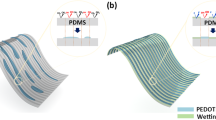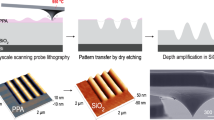Abstract
The ability to pattern surfaces on a microscopic length scale is of importance for technological applications such as the fabrication of microelectronic circuits and digital storage media. Devices fabricated entirely from polymers are now available, opening up the possibility of adapting polymer processing technologies to fabricate cheap, large-area devices using non-lithographic techniques1,2—for example, by exploiting dewetting3 and phase separation4,5,6 in thin films. But the final pattern adopted by the polymer film using such approaches requires a template printed onto the substrate by optical lithography, microcontact printing4,5 or vapour deposition3. Here we describe a simple process for patterning surfaces that does not require a template. Our method involves the spinodal dewetting of a polymer surface by a thin polymer film, in which a liquid film breaks up owing to the amplification of thermal fluctuations in film thickness induced by dispersion forces7,8,9,10,11,12,13,14. A preferred orientation is imposed on the dewetting process simply by rubbing the substrate, and this gives rise to patterns of remarkably well-aligned polymer lines. The width of these lines is well-defined, and is controlled by the magnitude of the dispersion forces at the interface, which in turn can be varied by varying the thickness of the polymer substrate. We expect that further work will make it possible to optimize the degree of order in the final morphology.
This is a preview of subscription content, access via your institution
Access options
Subscribe to this journal
Receive 51 print issues and online access
$199.00 per year
only $3.90 per issue
Buy this article
- Purchase on Springer Link
- Instant access to full article PDF
Prices may be subject to local taxes which are calculated during checkout




Similar content being viewed by others
References
Friend, R. H. et al. Electroluminescence in conjugated polymers. Nature 397, 121–128 ( 1999).
Service, R. F. Patterning electronics on the cheap. Science 278, 383–384 (1997).
Gau, H., Herminghaus, S., Lenz, P. & Lipowsky, R. Liquid morphologies on structured surfaces: From microchannels to microchips. Science 283, 46–49 (1999).
Böltau, M., Walheim, S., Mlynek, J., Krausch, G. & Steiner, U. Surface-induced structure formation of polymer blends on patterned substrates. Nature 391, 877 –879 (1998).
Heier, J., Kramer, E. J., Walheim, S. & Krausch, G. Thin diblock copolymer films on chemically heterogeneous surfaces. Macromolecules 30, 6610–6614 (1997).
Nisato, G., Ermi, B. D., Douglas, J. F. & Karim, A. Excitation of surface deformation modes of a phase-separating polymer blend on a patterned substrate. Macromolecules 32, 2356–2364 (1999).
Brochard-Wyart, F. & Daillant, J. Drying of solids wetted by thin liquid films. Can. J. Phys. 68, 1084–1088 (1990).
Xie, R., Karim, A., Douglas, J. F., Han, C. C. & Weiss, R. A. Spinodal dewetting of thin polymer films. Phys. Rev. Lett. 81, 1251– 1254 (1998).
Sferrazza, M. et al. Interfacial instability driven by dispersive forces: the early stages of spinodal dewetting of a thin polymer film on a polymer substrate. Phys. Rev. Lett. 81, 5173– 5176 (1998).
Reiter, G. Dewetting of thin polymer films. Phys. Rev. Lett. 68 , 75–78 (1992).
Krausch, G. Dewetting at the interface between two immiscible polymers. J. Phys. Condens. Matter 9, 7741–7752 (1997).
Lambooy, P., Phelan, K. C., Haugg, O. & Krausch, G. Dewetting at the liquid-liquid interface. Phys. Rev. Lett. 76, 1110–1113 (1996).
Stange, T. G., Evans, D. F. & Hendrickson, W. A. Nucleation and growth of defects leading to dewetting of thin polymer films. Langmuir 13, 4459 –4465 (1997).
Herminghaus, S. et al. Spinodal dewetting in liquid crystal and liquid metal films. Science 282, 916–919 (1998).
Israelachvili, J. Intermolecular and Surface Forces (Academic, London, 1992).
Jones, R. A. L., Norton, L. J., Kramer, E. J., Bates, F. S. & Wiltzius, P. Surface-directed spinodal decomposition. Phys. Rev. Lett. 66, 1326– 1329 (1991).
Acknowledgements
We thank K. Dalnoki-Veress and M. Sferrazza for help and advice with sample preparation and data analysis. We also thank G. Reiter for the suggestion that the magnitude of the Hamaker constant could be modified by varying the thickness of the lower polystyrene film. This work was supported by the EPSRC through the ROPA programme.
Author information
Authors and Affiliations
Corresponding author
Rights and permissions
About this article
Cite this article
Higgins, A., Jones, R. Anisotropic spinodal dewetting as a route to self-assembly of patterned surfaces. Nature 404, 476–478 (2000). https://doi.org/10.1038/35006597
Received:
Accepted:
Issue Date:
DOI: https://doi.org/10.1038/35006597
This article is cited by
-
Anisotropy in spinodal-like dynamics of unknown water at ice V–water interface
Scientific Reports (2023)
-
Self-organizing layers from complex molecular anions
Nature Communications (2018)
-
Dewetting Behavior of Hydrogen Bonded Polymer Complex Film under Hydrothermal Condition
Chinese Journal of Polymer Science (2018)
-
Controllable Plasmonic Nanostructures induced by Dual-wavelength Femtosecond Laser Irradiation
Scientific Reports (2017)
-
Giant Slip Induced Anomalous Dewetting of an Ultrathin Film on a Viscous Sublayer
Scientific Reports (2017)
Comments
By submitting a comment you agree to abide by our Terms and Community Guidelines. If you find something abusive or that does not comply with our terms or guidelines please flag it as inappropriate.



